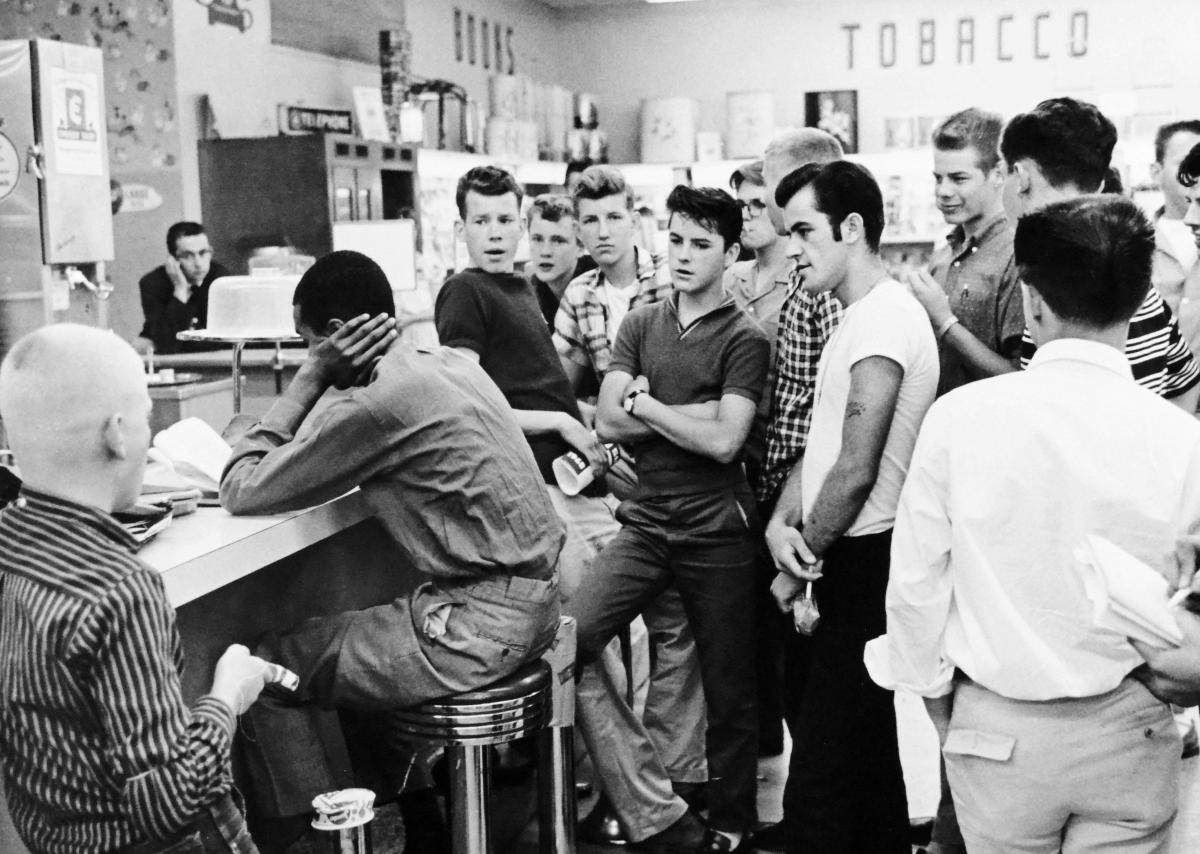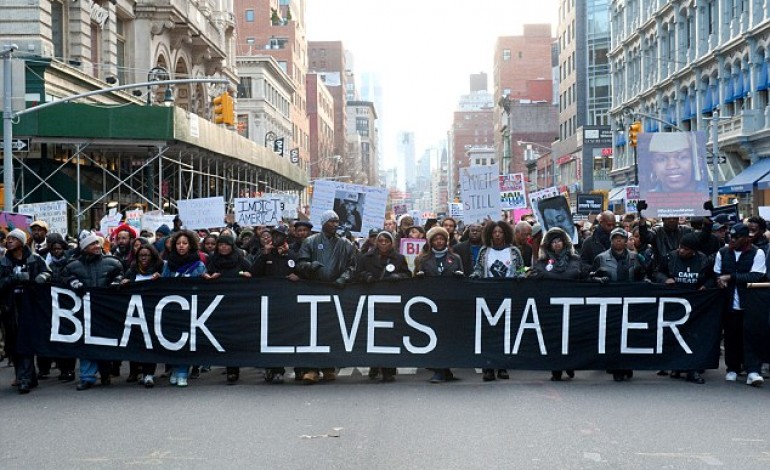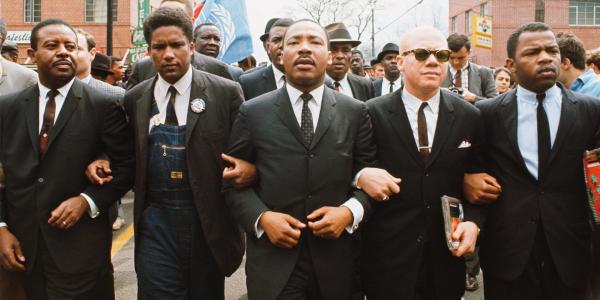From Civil Rights and Women’s Suffrage to the Tea Party movement and #MeToo, moral crusades can shape a society and an era. Pascal Boyer, an anthropologist and psychologist, investigates why people get involved, how movements gain traction, and what happens when they succeed.
Pascal Boyer, the Henry Luce Professor of Individual and Collective Memory at Washington University in St. Louis, has made confronting questions of tremendous scope and complexity something of a habit. His book Religion Explained addressed the origins of religious thought, and his new book, Minds Make Societies, brazenly tackles questions like: Why is there conflict between groups? What explains morality? What is social justice?
Much to the benefit of his students, Boyer takes the same approach in his teaching. Using an intellectual toolkit from a range of disciplines, this semester he guided students toward a greater understanding of a particularly complex and socially relevant set of ideas. As our nation grapples with #MeToo and Black Lives Matter, he and his students took a close look at the nature of social movements. What constitutes a moral crusade, they asked, and what causes such movements to flounder or thrive?
Right now, undergraduates at WashU spend their days navigating a historical moment of intense social and political division. This reality may be unsettling, but that doesn’t make it entirely unique – either historically or psychologically. Looking back over the centuries, Boyer noticed that humans have often tried to moralize issues when two groups are at odds with each other. There are numerous examples from history, including the American civil rights movement and women’s suffrage, as well as more sinister examples, like anti-Semitism in World War II.
In all of these examples, people sought to change aspects of society. “That made me wonder why people mobilize for certain causes and not others,” Boyer says. “Do you just have to be very passionate about a cause to join a movement? Or do you have to create conditions for people to join? So I thought if I could put together several examples, it could be a course that would be interesting.” These ponderings gave rise to the course “The Good Cause: Psychological Anthropology of Moral Crusades.”
The social side of cooperation

“I like to always see things from a totally cynical, biological, game-theory, economics, kind of way,” says Boyer, “but a good cause is a fly in the ointment.”
The suffragette and civil rights movements were inherently dangerous. In order to participate, activists risked their reputations, and in many cases, their lives. Yet even though joining these movements went against a human’s one true urge – to survive and procreate – hundreds of thousands went against their evolutionary wiring to try to better their own lots and the greater society.
“Imagine you're a woman in the 1910s or 20s, or if you're a black person in the 60s, why not just stay home and wait for the others to do it?” Boyer asks. Economists call this the “collective action problem.”
“The problem is that we can't achieve these things unless lots of people join in. But it's really in everyone's interest to not join in … so there have to be motivations and psychological phenomena that get us to actually take part, rather than wait for the results.”
One theory used to explain this phenomenon is rather simple: People who resent injustice more than others, or are more shocked by discrimination, join the demonstrations; those who are less affected or have a personality that makes them more indifferent do not join. But Boyer says this is not a very promising explanation.
"The problem is that we can't achieve these things unless lots of people join in. But it's really in everyone's interest to not join in…"

“It does explain some of it, but there are also some other factors,” he says. “For example, to what extent does your reputation or your status depend on you being a reliable person? To what extent do you perceive that others are joining? To what extent do you perceive the opposition as strong, cohesive, and determined? All those factors get into the picture.”
This complexity in decision-making was seen during the civil rights movement, when activists regularly put their physical safety at risk in order to protest injustice. In one famous incident, a group of high school students refused to move from whites-only spaces in a diner. Though the students undeniably showed bravery, Boyer says, fearlessness does not entirely account for their actions.
“Before they did that, they kind of psyched each other up for several days to have the guts to do it,” Boyer says. “So you have to have the guts, but you have to have other people around you to create this kind of dynamic. I thought this was really interesting because that kind of dynamic is something that is not specific to a particular place or time. That it's something that we humans do that helps us do collective action.”
An evolutionary take
According to economists, collective action should never occur in dangerous situations. But it does happen, and it’s not that rare of a phenomenon. As in the case of the teens in the diner, social influence can provide a partial explanation. In addition, Boyer credits human cooperation to something far more deeply engrained. He and other evolutionary anthropologists and psychologists say that collective action is probably good for our survival and genetic fitness.
“Humans are cooperators,” Boyer says, “but they're cooperators situations in which they have a lot of knowledge of each other's actions. They have memory, and they have language to communicate information about others very clearly. That makes reputation very important. It creates a sort of market in human societies between people who are better cooperators and people who are less good cooperators.”
People signal their willingness to cooperate by engaging in exchanges that are mutually advantageous and by not trying to exploit others. Sometimes this includes extending favors knowing they may never be reciprocated.
"That makes reputation very important. It creates a sort of market in human societies between people who are better cooperators and people who are less good cooperators."
“If you give people directions on campus, you don't expect them to pay you. OK well, why not?” Boyer asks. “The evolutionary psychology account would be that these dispositions are precious enough that others would want to cultivate them, and therefore favor them. These people – over hundreds of thousands of years – would have had more genetic success than others. And that's why most human beings are more cooperative than any other species.”
According to Boyer, this instinct is deeply rooted. Recent evolutionary psychology research shows that humans have a rather outdated sense of our societies.
“There are interesting studies that show people vastly overestimate the likelihood that they will meet again someone they've just met,” says Boyer. “One possible explanation for this is that we evolved in societies where that was the case. They were only 500 or so people around, so if you met someone, you'd probably meet them again. And because of that, it would be a good strategy to cooperate with them rather than be selfish.”
This evolutionary history offers a potential explanation for our surprising capacity for collective action. Behavioral economists and evolutionary psychologists have worked on these issues for 20-30 years, and over and over again, in economic games, people are more generous than economic theory suggests they should be.
From social movement to moral crusade
Knowing why people participate does not explain why some causes gain traction while others fizzle. What makes a successful cause? To start examining this question, Boyer and his class looked at two examples of efforts to lower taxes in the U.S.

In 1985, political activist Grover Norquist founded an advocacy group called Americans for Tax Reform. “His position is, basically, that it's better for people to have that money to spend instead of the government,” Boyer says. “That's it. And the idea is that it should mobilize people because it tells them you should have more money, and the government should have less. He's managed convince lots of lobbyists and other agents like that, but it's not a popular movement.”
The more recent Tea Party movement serves as an interesting point of comparison. In his class, Boyer invited his students to consider the ways in which the Tea Party appealed to citizens’ moral sensibilities.
“That was a much more moralized movement,” Boyer says. “While the idea is rooted in taxes and government, you then add the idea that the government is intrinsically corrupt and that participants are like the original, true Americans who dumped tea chests into Boston Harbor – that they are true patriots rather than the elitist officials in ‘the swamp.’”
According to Boyer, such invocations of morality can transform an ineffectual movement into an emotionally charged crusade. Without a moral component, movements “get much less mobilization,” he explains. “You could get very efficient lobbying and politicking, but you don't get people out marching. What makes a moral crusade is the intuition that what you’re trying to achieve would not just make society better for you, but make society better. Full stop.”
"What makes a moral crusade is the intuition that what you’re trying to achieve would not just make society better for you, but make society better. Full stop."
The successful crusade
Even when appealing to morals, not all crusades succeed. Another deciding factor is the clarity of the movement’s objectives. When a movement has clear goals — getting women the right to vote, granting civil rights to all Americans, allowing LGBTQ individuals to marry — it’s more likely to succeed in the long-term. However, some crusades, like the Salem witch trials, the Red Scare, and even LGBTQ persecution in some African countries, fail because panic and outrage overcome any other impulse.
“Often, you get a dynamic where people are extremely committed to a cause,” Boyer says. “It has a strong moral component, which whips people into a frenzy, but in the process, the description of the target becomes rather fuzzy. And these two factors feed each other. As the enemy becomes less specific, the movement gets stronger precisely because the target isn’t clearly defined. They could be anywhere, so you feel greater danger than before.”
"These two factors feed each other. As the enemy becomes less specific, the movement gets stronger precisely because the target isn’t clearly defined."
In Boyer’s opinion, even the current #MeToo movement could be considered a moral cause that lacks clarity. “Structurally, #MeToo is very much like the witch trials — and that may seem shocking,” he says. “But think about it. There are examples of disgusting people doing disgusting things, and there's a movement to root out others, using sometimes innocuous actions to confirm that they are guilty.”
Boyer and his class looked at how even “bad” causes can succeed with a strong moral component and clear objectives. Terrorist cells are a great example of people “who are intensely moralized and think they are doing something they should do for the greater good,” Boyer says. “It’s not a matter of self-interest; it’s what philosophers call ‘deontic rule.’ It’s something you must do because the world will be a better place once your cause has won.”
Success is just the beginning
When earnest morals pair with clear objectives, crusades can and have reached their goals. In 1920, American women achieved the right to vote. With the passage of the Civil rights, Voting Rights, and Fair Housing Acts in the late 1960s, civil rights protestors achieved their initial aim of ending legalized racial segregation and discrimination.

Following such successes, “rationally, you should just dissolve the movement,” says Boyer. “But that doesn’t always happen.” A recent example of this, he says, is the British exit from the European Union. The leadership behind the so-called Brexit came from a social and political movement that solidified into UKIP, the UK Independence Party. UKIP had only one goal – to get a referendum on British exit from the from the European Union. Eventually, they got the result that they wanted.
The day after the referendum passed, about half the movement’s leaders said, “‘OK we'll disband and go home,’” says Boyer. “But there still is a UKIP, and now they've changed the goalposts.” This type of evolution is not unique to the Brexit movement, he says.
“When you have a movement, and that movement has a certain agenda, very often you rewrite the agenda as things go because you are motivated by a broader moral vision,” he says. “For example, in the UKIP party, the idea is defending Britain and its uniqueness against dissolution into a global world. Now that the referendum has passed, they are thinking about what more they want to do.”
By examining examples such as these, students in “The Good Cause: Psychological Anthropology of Moral Crusades” gained context and insight into today’s social movements and debates. In the Unites States, women continue to fight against sexism and to advocate for causes like equal pay and better access to reproductive health care. The moral crusade against prejudice and systemic racism has likewise found new avenues of action, as in the Black Lives Matter movement.

With competing morals and goals at stake, today’s crusaders appear to be constantly in conflict with opposing forces. “Political debate about important issues has become completely intractable,” Boyer says. “The last election made lots of people think about that. How come we are so different? We can't even imagine each other's political choices.”
“But it seems to me,” Boyer says, “if you talk to people who study history, it's more or less what you would expect in human societies.” Though movements come and go, moral causes only evolve. New cracks in the system are found even as new rights are won, and so people continue to fight their moral crusade.




